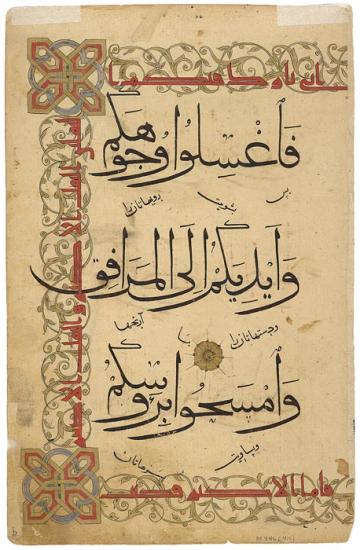
Washing Before Prayer
Qur˒an leaf, in Arabic and Persian
Bequest of Belle da Costa Greene, 1950
Although the Morgan has two leaves from this Qur˒an (see also MS M.846.4a), they are not consecutive, and thus their borders do not match. This page includes verse 6 of sura 5 (al-Mā˒ida, or "The Table"), urging the washing of faces, hands, and arms up to the elbow before praying. The silver Kufic inscription, a Shi˓ite hadith (a saying of Muḥammad), says that the words of ˓Alī and the succeeding imams have the same authority for Shi˓ites as those of the Prophet for Sunni Musliims: "I am going to leave you two valuables, the greater valuable and the lesser valuable. The greater is the book of my god, and the minor is my family and the people of my house [i.e., the twelve Shi˓ite imams]. If you preserve me through them you will never go astray so long as..."
(the text on this page breaks off here).
The Qur˒an, the Holy Book of Islam
From a monumental volume used in an Istanbul mosque to a miniature Persian version that served as a talisman, this section features examples of illuminated pages from the holy book of Islam. The Qur˒an (to recite) represents the codification of the words of God that were revealed and transmitted through the angel Gabriel to the prophet Muḥammad (ca. 570–632) over a period of twenty-three years. The visions began in 610 in a cave on Mount Hira near Mecca, his birthplace, and continued after his 622 flight to Medina, until his death. His flight—the Hijra—marks the beginning of the Islamic calendar.
The revelations were arranged into 114 suras (chapters), each named after its theme. The first and shortest ones, at the end of the book, from the Meccan period, establish Muḥammad as the final prophet in a line of monotheists, including Abraham and Jesus. The longest suras, placed at the beginning, are Medinan and deal more with social and political issues.
For centuries, Qur˒ans were written in Arabic, the language of transmission. After Muḥammad's death, his cousin ˓Alī and others compiled the revelations into a text. About twenty years later, under Uthman, the third caliph (644–656) succeeding Muḥammad, a standard version of the Qur˒an —essentially the one used today—was produced. Thereafter Islam (which means "surrender to God") spread from the Arabian Peninsula throughout the Middle East, to northern Africa and southern Spain, and eventually the world.
